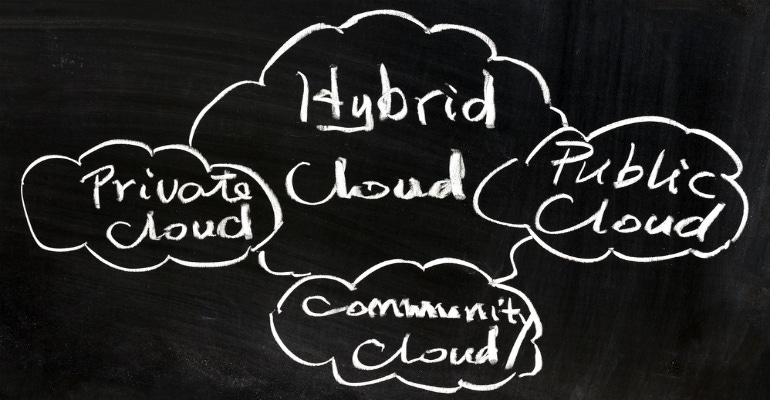The migration from legacy IT to multicloud environments will force a shift in technology, which will disrupt the channel partner space. And that disruption will create both risk and opportunity.
April 24, 2018

By Michael Bushong
For most of the last two decades, the enterprise networking space has been at an equilibrium point. Architectures have remained fairly static, and that has driven a dynamic that favors incumbency. But as cloud and multicloud emerge as the go-forward enterprise architectures, it seems certain that the market will find a new equilibrium — and the channel’s long-term viability hangs in the balance.
So how should partners prep for a successful multicloud future?
First, understand that cloud architectures require more than just hyperscale providers. Yes, the public cloud is a foundational element of multicloud. But customers who believe that the boundaries of change will be contained to just the public cloud space might be surprised.
The premise of cloud is that the underlying infrastructure ought to be invisible. That is to say, a user should not be able to tell if a workload is served from on-premises infrastructure, in AWS or in some distributed telco cloud. And it shouldn’t matter if a user is at corporate headquarters, in a branch office or working remotely. This means that infrastructure management has to extend well beyond the public cloud itself, to the onramps to the cloud that exist in both the campus and branch.
Redrawing the boundaries around more of the infrastructure might not seem like a big deal. But if the underlying requirement is that policy and control be unified end to end, then channel partners will be forced to service more than just one part of the network. A reseller that is, for instance, strong in campus but has no meaningful data-center business, will find itself vulnerable.
Of course, this diversity also means that channel players can leverage strength in one part of the network to expand their footprints into others. By extending a solution from the campus into the data center and public cloud, and then securing it all, partners can provide multicloud infrastructure services that widen their circles of influence.
Software Continues Its Feast
It’s become cliché to declare that software is eating the world, but the fact is that value is certainly transitioning from the underlying devices into the software layers that make those devices behave as a cohesive infrastructure. In the networking space, the rise of software-defined networking, for instance, is critical if the end-to-end policy and control ambitions of multicloud are to be satisfied.
Minimally, this means that channel partners need to open their line cards to include orchestration and control products. But more importantly, the expansion of software will force a change in pricing mix across the solutions.
Assume that IT spend is largely flat, or that it fluctuates with broader economic conditions rather than changes in solution components. If enterprises need to procure the same hardware and additional software, it means that the price of the hardware will naturally compress. As that happens, resellers whose business is dominated by hardware will feel the squeeze.
It seems obvious that channel partners will want to seek out these new products early so that the transition of business happens under their terms. Resellers that fail to make this early shift will find themselves out of position, which can ultimately represent an existential threat.
You have some time — any major technology transition is more of a journey than an instantaneous cutover. And, you have a services opportunity because as enterprises grapple with evolving their architectures, tooling, processes and people, they will rely on more than just products.
Channel partners that anticipate this journey will find that they can position themselves as more than resellers. By developing services, support and education offerings, they can both expand their portfolios and offer more value to customers challenged with making such a massive shift.
These services will naturally be higher-margin, which will be important as value moves from the underlying hardware to the software and services that ride on top. But more importantly, as hardware is relegated to interchangeable parts that can be supplied by multiple vendors, the only thing keeping a partner in a lead position in an account will be these newer offerings.
Gearing Up for Multicloud
If your business is built on incumbent solutions, you need to find ways to expand your portfolio to introduce software solutions and alternate suppliers. Failing to create optionality in the product catalog will unnecessarily bind resellers to the fates of their incumbent suppliers.
Of course, opening up your portfolio to plan for the future creates short-term risk. After all, companies might not want to bite the hand that feeds. Creating new solutions in non-competing categories will be key. Introduce orchestration solutions or automation packages that work in heterogeneous environments, for example. The Open Network Automation Platform, or ONAP, project is an example. This will allow you to become more familiar with higher-margin software layers without necessarily disrupting existing offerings.
For challengers, multicloud is probably more exciting. A rich set of software services, likely centered around automation, visibility and orchestration, will be highly valuable for customers navigating the operational challenges of multicloud migrations. Developing the tools and education practices to train enterprises on how to operate in a more agile multicloud world will yield immediate opportunity.
Whatever the position – incumbent or challenger – it’s obvious that change is coming. The real question is whether to treat that disruption as threat or opportunity.
Michael Bushong is vice president of enterprise and cloud marketing at Juniper Networks. Mike spent 12 years at Juniper in a previous tour of duty, running product management, strategy and marketing for Junos Software. Most recently, Mike was responsible for Brocade’s data center business as vice president of data center routing and switching, and then Brocade’s software business as vice president of product management, software networking.
You May Also Like
